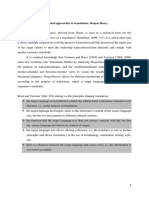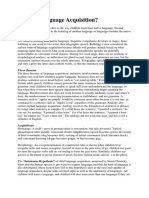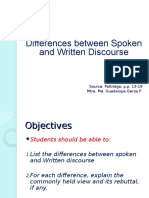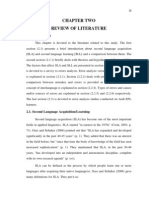0 ratings0% found this document useful (0 votes)
677 viewsSkopos Theory
Skopos Theory
Uploaded by
IstizpThis power point contains a general discussion of Vermeer's Skopos theory along with its application in describing English-Indonesian translation of Nescafe's homepage.
Copyright:
© All Rights Reserved
Available Formats
Download as PPTX, PDF, TXT or read online from Scribd
Skopos Theory
Skopos Theory
Uploaded by
Istizp0 ratings0% found this document useful (0 votes)
677 views7 pagesThis power point contains a general discussion of Vermeer's Skopos theory along with its application in describing English-Indonesian translation of Nescafe's homepage.
Original Title
Skopos Theory PPT
Copyright
© © All Rights Reserved
Available Formats
PPTX, PDF, TXT or read online from Scribd
Share this document
Did you find this document useful?
Is this content inappropriate?
This power point contains a general discussion of Vermeer's Skopos theory along with its application in describing English-Indonesian translation of Nescafe's homepage.
Copyright:
© All Rights Reserved
Available Formats
Download as PPTX, PDF, TXT or read online from Scribd
Download as pptx, pdf, or txt
0 ratings0% found this document useful (0 votes)
677 views7 pagesSkopos Theory
Skopos Theory
Uploaded by
IstizpThis power point contains a general discussion of Vermeer's Skopos theory along with its application in describing English-Indonesian translation of Nescafe's homepage.
Copyright:
© All Rights Reserved
Available Formats
Download as PPTX, PDF, TXT or read online from Scribd
Download as pptx, pdf, or txt
You are on page 1of 7
At a glance
Powered by AI
The key takeaways are that Skopos theory considers translation as a purposeful human action and that the purpose or aim (skopos) determines the translation. The translator should know why the source text is being translated and what function the target text will have.
The main principles of Skopos theory are that a translational action is determined by its aim or purpose, and the target text must be appropriate for its intended purpose or function in the target culture and language.
The rules in Skopos theory are: 1) A translational action is determined by its skopos 2) The target text offers information to the target culture 3) The target text does not allow fully reversible translation 4) The target text is internally coherent 5) The target text is coherent with the source text 6) The skopos rule has hierarchical precedence over the other rules.
Skopos Theory
Hans J. Vermeer & Katharina Reiss
• Skopos: aim or purpose
• It is based on action theory, hence it considers translation as a type of
human action containing an intention or a purpose.
• Skopos theory argues that translational action is determined by its aim or
purpose and has an outcome namely TT or Translatum which must be fit
for purpos.
• Thus, a translator should:
know why a ST is to be translated
what the function of the TT is
Rules in Skopos Theory
1. A translational action is determined by its skopos.
2. It is an offer of information (Informationsangebot) in a target culture
and TL concerning an offer of information in a source culture and SL.
3. A TT does not initiate an offer of information in a clearly reversible way.
4. A TT must be internally coherent (Coherence Rule)
5. A TT must be coherent with the ST (Fidelity Rule)
6. The five rules above stand in hierarchical order, with the skopos rule
predominating.
Comments on Skopos Rules
• The rules are seen as the downplaying or the ‘dethroning’ of the ST.
• Nord’s Functionality Plus Loyalty Principle states that there needs to be a
relationship between ST and TT, and the nature is determined by the
skopos.
• Loyalty: the target-text purpose should be compatible with the original
author’s intentions.
• Skopos Theory allows a same text to be translated in different ways
depending on the purpose and commission.
Goal (TT or Translatum)
• Translation commission or ‘brief ’ contains
Conditions under which the goal should
be achieved (deadline, setting, fee, etc.)
• If the TT fulfils the skopos outlined by the commission, it is functionally
and communicatively adequate.
• In general, Skopos theory reduces equivalence to functional constancy
(cases where the function of ST and TT are the same).
Discussion of Skopos Theory
• It is only for non-literary texts, because the literary ones do not seem to
exhibit any purpose.
However, Vermeer states that goals, purposes, functions, and intentions
are ‘attributed to’ actions. Every reception and reproduction of a text
can at least have one skopos.
• There is no sufficient attention to the linguistic nature of ST and the
reproduction of micro-level features in TT.
• Purpose: Welcoming website’s visitors from various countries • Purpose: Welcoming website’s visitors from Indonesia
• Visual elements: • Internal coherent:
- Dominated with red and blue - A picture of two glasses of Nescafe placed in a table
- A picture of people in a beach holding glasses of Nescafe • Coherence with the ST:
- Full-screen photo layout - Dominated with red and brown
• Textual elements: - The same layout as in the ST
- Presenting information about Nescafe’s year of establishment - Presenting similar information, but the Nescafe’s
and its commitment “grow coffee respectfully”. It is followed commitment “menanam kopi dengan hormat” is questionable
by “Grown Respectfully” section and is not followed by “Grown Respectfully” section.
You might also like
- Almanna 2013 Translation Theories Exemplified From CiceroDocument173 pagesAlmanna 2013 Translation Theories Exemplified From CiceroNisreen AwadallahNo ratings yet
- JEREMY MUNDAY Chapter 1Document8 pagesJEREMY MUNDAY Chapter 1Wera RudNo ratings yet
- Munday CH 5.3-5.3.1 Skopos TheoryDocument11 pagesMunday CH 5.3-5.3.1 Skopos TheoryEvelina Tutlyte100% (1)
- Functional Approaches To Translation. Skopos TheoryDocument3 pagesFunctional Approaches To Translation. Skopos TheoryLorelai Brezoi75% (4)
- Functional Approaches To Translation. Skopos TheoryDocument4 pagesFunctional Approaches To Translation. Skopos TheoryLoredana Iacob100% (1)
- Performance in Language LearningDocument6 pagesPerformance in Language LearningDedeh Kurniasih0% (1)
- Skopos Theory:: Basic AspectsDocument30 pagesSkopos Theory:: Basic Aspectsعبد الرحيم فاطمي100% (2)
- Skopos Theory: Translation BriefDocument2 pagesSkopos Theory: Translation BriefIshrat FatimaNo ratings yet
- Translation Studies Chapter 4, 5 and 6Document30 pagesTranslation Studies Chapter 4, 5 and 6Anonymous R99uDjY100% (1)
- The Writing Difficulties Faced by L2 Learners and How To Minimize ThemDocument8 pagesThe Writing Difficulties Faced by L2 Learners and How To Minimize ThemNuru JannahNo ratings yet
- The Concept of Second Language Acquisition (SLA)Document34 pagesThe Concept of Second Language Acquisition (SLA)Sherwindle100% (1)
- Discourse Linguistics: Discourse Structure Text Coherence and Cohesion Reference ResolutionDocument41 pagesDiscourse Linguistics: Discourse Structure Text Coherence and Cohesion Reference ResolutionJun Rey Prudz-Otare Estdo100% (1)
- Critical Period Hypothesis SummaryDocument2 pagesCritical Period Hypothesis SummaryFRANCISCO DURANNo ratings yet
- Chapter 1-INTRODUCTION TO TRANSLATIONDocument19 pagesChapter 1-INTRODUCTION TO TRANSLATIONDiệp Nhược ThiênNo ratings yet
- Lecture 1-Types of Islamic Texts and Their Characteristics-Translation of Proper NamesDocument11 pagesLecture 1-Types of Islamic Texts and Their Characteristics-Translation of Proper Namesyoshi hiNo ratings yet
- What Is Language AcquisitionDocument3 pagesWhat Is Language AcquisitionWilliam DrakeNo ratings yet
- 3 - Clarifying Translanguaging and Deconstructing Named Languages - A Perspective From LinguisticsDocument28 pages3 - Clarifying Translanguaging and Deconstructing Named Languages - A Perspective From LinguisticsUk mats100% (1)
- Differences Between Oral and Written DiscourseDocument44 pagesDifferences Between Oral and Written DiscourseMj ManuelNo ratings yet
- Elec 1 Stylistics and Discourse Analysis Module 1Document5 pagesElec 1 Stylistics and Discourse Analysis Module 1Ken PepitoNo ratings yet
- Differences Between Spoken and Written DiscourseDocument20 pagesDifferences Between Spoken and Written Discoursehugoysamy29100% (1)
- Main Points of Inter Language, Krashen, andDocument22 pagesMain Points of Inter Language, Krashen, andCikgu MelurNo ratings yet
- Introduction To StylisticsDocument10 pagesIntroduction To StylisticsxxxxNo ratings yet
- Stylistics Module 1Document6 pagesStylistics Module 1Eman Bandoquillo100% (1)
- Affective Factors in Second Language AcquisitionDocument12 pagesAffective Factors in Second Language AcquisitionAlberto AmaroNo ratings yet
- Assessing ListeningDocument23 pagesAssessing ListeningmounaNo ratings yet
- Style and StylisticDocument9 pagesStyle and StylisticAnonymous 6rSv4gofkNo ratings yet
- Jeremy Munday-Chapter 3Document5 pagesJeremy Munday-Chapter 3Wera RudNo ratings yet
- Corpus Linguistics PresentationDocument25 pagesCorpus Linguistics PresentationMałgorzata Warzecha100% (1)
- The Natural ApproachDocument20 pagesThe Natural ApproachPremaria MahaputriNo ratings yet
- ELC 413 - Philippine EnglishDocument9 pagesELC 413 - Philippine EnglishIan Paul Hurboda DaugNo ratings yet
- Introduction To Linguistics WorksheetDocument2 pagesIntroduction To Linguistics WorksheetHilario Satria Delima100% (1)
- Traditional GrammarDocument3 pagesTraditional GrammarCarmen HdzNo ratings yet
- Translation Studies Question Paper 2021 OBEDocument3 pagesTranslation Studies Question Paper 2021 OBEanasraheelNo ratings yet
- The Concept of EquivalenceDocument6 pagesThe Concept of Equivalenceabril iñon rukavinaNo ratings yet
- NU Seggestion-2019 (Approach and Methods of Language Teaching)Document44 pagesNU Seggestion-2019 (Approach and Methods of Language Teaching)Afroz ShirinNo ratings yet
- Lexical and Structural AmbiguityDocument12 pagesLexical and Structural AmbiguityNur Auni Baharuddin100% (12)
- Cognitivism (Applied Linguistics)Document18 pagesCognitivism (Applied Linguistics)IKadekDonySuantika0% (1)
- Translation Theories, Strategies, and Basic TheoreticalDocument23 pagesTranslation Theories, Strategies, and Basic TheoreticalUn_Djannah67% (3)
- Christiane Nord 2002 Manipulation and Loyalty in Functional TranslationDocument15 pagesChristiane Nord 2002 Manipulation and Loyalty in Functional TranslationJoao Fanequico100% (2)
- 07 - Chapter 2 SLA TheoriesDocument73 pages07 - Chapter 2 SLA TheoriesPerlita VegaNo ratings yet
- Genre AnalysisDocument19 pagesGenre AnalysisTHE PROFESSORS'100% (1)
- Grammar Translation MethodDocument3 pagesGrammar Translation MethodSafazzuan Sazuki100% (1)
- Universal GrammarDocument7 pagesUniversal Grammaranon-795907100% (2)
- Translation Studies 1Document8 pagesTranslation Studies 1007 M DivyaNo ratings yet
- BilingualismDocument19 pagesBilingualismafiqah100% (1)
- Summery of Cognitive AccountsDocument2 pagesSummery of Cognitive AccountsDaryantoNo ratings yet
- Hafiz Sherazi (1325-1389)Document9 pagesHafiz Sherazi (1325-1389)ToshibakhonNo ratings yet
- 06 - Branches of StylisticsDocument38 pages06 - Branches of StylisticsKashif Iqbal MS Student EarthQuake-Spring 22100% (1)
- Grammar NotesDocument21 pagesGrammar NotesSuriani DaudNo ratings yet
- 1Document9 pages1sumayya tariqNo ratings yet
- Semantics Refers To The Ways in Which A Language Conveys MeaningDocument4 pagesSemantics Refers To The Ways in Which A Language Conveys MeaningVichitra Kumarian100% (1)
- The Importance of Understanding Micro-Skill of Listening in Material DevelopmentDocument3 pagesThe Importance of Understanding Micro-Skill of Listening in Material DevelopmentAthiya FidianNo ratings yet
- Grup One - What Do Sociolinguist StudyDocument11 pagesGrup One - What Do Sociolinguist StudyPusri YahNo ratings yet
- Implicature PrgmaticsDocument18 pagesImplicature PrgmaticsAin Na Tkah100% (1)
- Subtractive and Aditive BilingualismDocument9 pagesSubtractive and Aditive BilingualismAida Araceli Lizárraga ÁvilaNo ratings yet
- The Translation Shift ApproachDocument12 pagesThe Translation Shift Approachpalala8989% (9)
- (Elt) The Linguistics of Contrastive AnalysisDocument22 pages(Elt) The Linguistics of Contrastive Analysislolalo123100% (2)
- Technology Era in Literary TranslationDocument5 pagesTechnology Era in Literary TranslationIldikó Olasz100% (1)
- Translation: Functionalism in Translation StudiesDocument25 pagesTranslation: Functionalism in Translation StudiesMuhammad AliNo ratings yet
- Skopos TheoryDocument10 pagesSkopos TheoryAseel ZalatNo ratings yet



























































